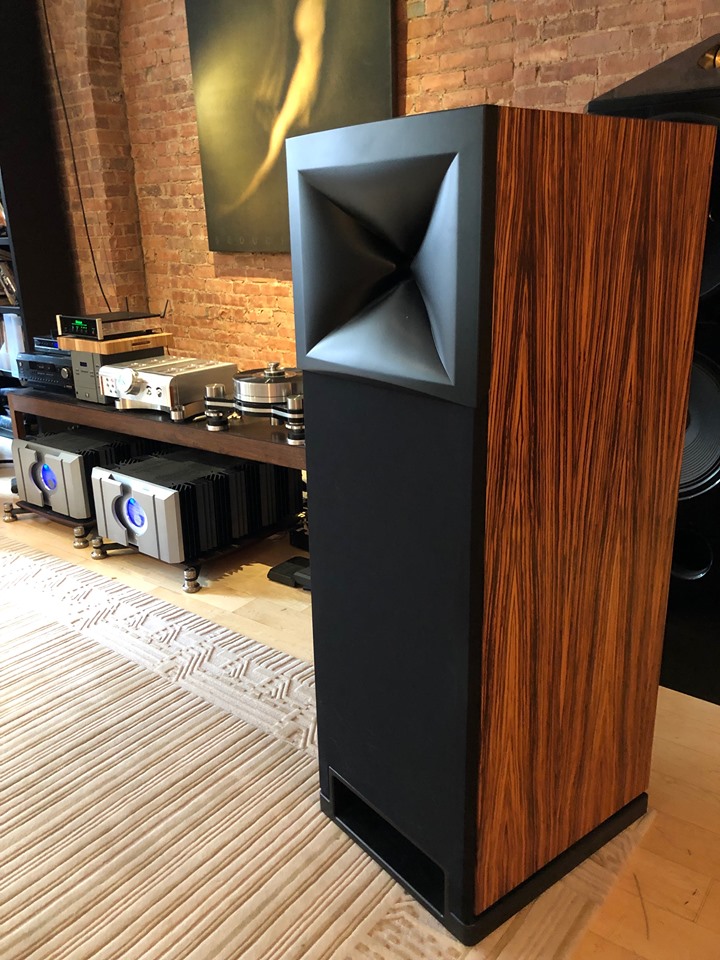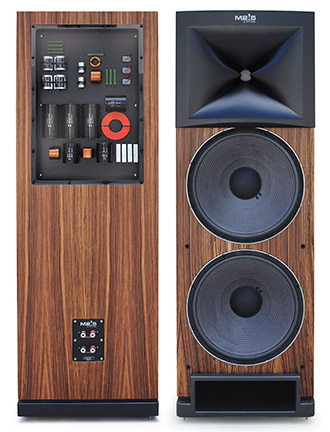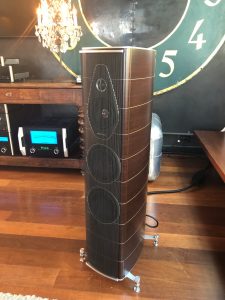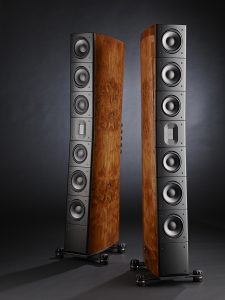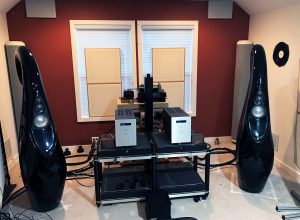These days there are a lot of good speakers out there. More than ever, at every price point you can surely find something that fits your needs. As the price rises, the scrutiny and expectations grow, as well they should. At or around the $30K mark there have never been so many choices in all manners of design, materials, and technology. At the upper echelon, manufacturers have really pushed the state of the art in terms of secret composite materials for cabinets housing exotic drivers made from carbon fiber, ceramics, and other space age materials. Some coated in different formulas of elixirs, all with the intention to perfect the pistonic response, and lighten the mass of the driver. Also, manufacturing capabilities have greatly advanced and computer modeling has helped to clear the hurdles every designer faces. As a result, what was truly impossible 20 years ago is constantly being eclipsed by the next big breakthrough. But what if, in the right hands, the technology and materials that have been around for decades could give even the most advanced state of the art designs a run for their money? What if everything we needed for reference level sound has just been waiting for the right mind and pair of hands to show us how its done?
Let me introduce to you Mr.Peter B. Noerbaek, founder, designer and manufacturer of PBN / Montana speakers, amplifiers, and some of the most stunning direct drive turntables you will ever see. Peter and his company, PBN Audio, just celebrated 27 years in business. That is no small feat. To keep the lights on, and doors open, for that stretch in the world of high performance audio, without proving day in and day out his products are worthy, would be impossible. I have been stalking PBN for at least 10 years, give or take. In the last couple of years I began dropping Peter a message every so often. I never really pushed for a review until Peter could not contain his excitement about his new reference Olympia mono amplifiers. He agreed to get me a pair to review, but commerce comes first and Peter was selling them as fast as he could make them. So I kept my powder dry and review calendar filled. One day Peter offered for review what he referred to as, "The best speaker I ever made," to be built fresh and sent over to my NYC loft. To be honest, just by the looks of the M2!5, with its throw back horn loaded compression tweeter / mid band dual driver and what appeared to be just another square cabinet that happens to house two 15" paper cone drivers per side, they didn't fit the typical profile for my more modernist taste. I could imagine the cabinet in a great high gloss white or color, upping the modernist quotient (Peter would be happy to paint them any color you'd like). However, I had grown to really trust Peter, and despite a bum shoulder, I agreed to receive and wrestle the 280lb speakers out of the crates and into the hot spot.
The first thing I noticed was the craftsmanship. Peter does not cut corners when it comes to getting the details right. The cabinets were perfect, and the veneer finished in a satin varnish looked very nice. The back panel, with its window exposing the exquisite crossover, is a sight to behold. Despite the 280lb weight, the M2!5 slid out of the crates with ease, which was a relief for a one armed bandit like myself. The spikes were a breeze to insert, and not a hiccup to be found at any point of installation or use.
To paraphrase from PBN's website- The Precision-made cabinet has a faceplate of 1.75" layered MDF. Highly engineered inner chambers are designed to produce the most accurate measurable audio. Twin 15" woofers with with a low-loss magnetic structures and symmetrical field geometry are matched to the internal enclosures producing accurate mid-bass. Mid-range / tweeter are compression drivers with dual-diaphragms. The drivers are aligned "in time" via their 900 Hz charge-coupled crossovers. The M2!5 uses PBN's proprietary 30 db per octave acoustical crossover slopes. Sensitivity is 95dB / 2.83V / 1M. Frequency response is 25Hz-20kHz. Impedance is 4 Ohms.
I initially used the new Krell K300i integrated, as I was completing its review. Do not balk at the combo. The Krell was wonderful, and its 150 watts per side proved to really wake up the 95 dB efficient M2!5. The K300i was very sweet sounding, and very engaging. At $8K, including an outstanding DAC, it's a steal. Next came the twice the price Gryphon Diablo 300 integrated. Fed by the outstanding VPI Avenger Reference, with the ever engaging ORTOFON MC Windfeld Ti cartridge and the mighty-mite Boulder 508 phono stage which impressed me so much, I had to buy it.
The Diablo 300 has its own DAC option as well, and fed by the McIntosh MB50 steamer I had the best of both worlds. The Diablo 300 integrated amplifier is simply a monster. With the all MIT Reference Interface hooking it all up, the Diablos's 300-watts grabbed the M2!5 by the short hairs. Listening to Billy Cobham's Best Hits, the dynamics of the drum kit came as close to a real kit being pounded on as I've ever heard. Two 15" drivers per side, when done correctly, and correctly they are done here, never give up and never start to boom, compress, or distort. The bass drivers, much like the upper frequencies, just get louder and cleaner the more that is asked of them. From there we went to the wonderful Pass XA200.5 Class A mono block amplifiers, and the D'Agostino Momentum preamplifier. I had industry PR stalwart Adam Sohmer over for a visit, and the look on his face when Stanley Clarke's "I'm Home Africa" from East Riverside Drive locked into the room, and just clobbered us at the listening chair. I'll never forget the look on his face, or the feeling in my gut. The pugilistic thumping we took reminded me of nothing short of body shots from a 20 year old Mike Tyson. This continued, whether listening to well recorded metal, or orchestral tympani. There really is no substitute for driver surface area, and with a room measuring 33' x 60' x 14', I can use all the driver surface area I can get. Low frequency control and power at high decibels is endlessly entertaining and extremely realistic with the M2!5. Now, of course, playing loud is a blast and it has its place, but the M2!5 delivers outstanding pitch and tone at all volumes. Voices, such as Sarah Vaughn's previously unreleased limited edition vinyl from Devialet, was remarkable in its ease and realism. The driver to driver coherency is as good as I've ever heard from a speaker utilizing different driver technologies producing a sound that speaks with one voice.
Another area that really grabbed me was how well it handled the piano and its complex harmonic structures. After a fundamental is stuck most speakers will find a way to choke off the bloom and gentle decay of the note making the note sound flat and unrealistic. The M2!5, on the other hand, does a remarkable job at letting the harmonics fly freely into space, decaying at their own natural pace, regardless what's happening around it. Red Garland "On Green Dolphin Street" (a song my father, a very accomplished jazz pianist, used to play for me on my birthday every year till his passing) was given new life; a brand new sonic signature. The instrument gained bloom, effortlessness, and openness. Everything about well recorded piano just sounded fantastic through the M2!5, while other speakers may have sounded just good. Another great piano recording is from Brian Bromberg's Wood. "Song For My Father" features some marvelous piano playing. The piano blooms and flows with the lower registers taking on the proper weight, while increasing the complexities of individual notes attacks, sustain, and decays.
Now, for those that value super fine pinpoint imaging and crisp delineated outlines, you may or may not, at first blush, totally "get" the M2!5. Images are rounder and they may have more body and weight than what you may be used to. They are bolder and more present, in the room, as experienced by my friend and publisher of the Audiophiliac, Steve Guttenburg, who waxed about his experience of the M2!5 during our video interview for his blog on YouTube. After playing "Willow Weep For Me" from Duke Ellington's Mood Indigo, it was goose bumps all around. There is a presence and tangibility to the M2!5 that simply evades other far more expensive speakers that I will not mention here. In this regard, the M2!5's presentation is simply closer to live music, and less like a reproduction.
These ears are a bit spoiled when it comes to high frequencies thanks to my long term reference Lansche 4.1 with its plasma tweeter. There is no finer tweeter that I've heard. No mass, just a ball of fire that expands and contracts creating sound. If that sounds like something out of science fiction, it kind of is. Its Achilles heal is found when the music gets way too loud. It compresses, and can cause failure. Typically, I'd have to spend time acclimating to a non plasma tweeter. Even if well designed, my ears usually can hear what the tweeter is contributing. The M2!5 required no such adjustment period. The implementation of the dual compression mid band and treble drivers just lock in, and sound totally integrated. It is neither bright nor brittle. It doesn't harden or compress at higher volume. It's not super fast sounding, nor is blunted. It just sails along and remains at the service of the music. Very well done.
When it comes to fleshing out a stage, the sense that an orchestra is in the room, and the scale in which it is spread across the space is uncanny. While I won't slam any manufacturers by name, I will say another guest, a former french horn player for the Dallas Symphony, and rabid audio enthusiast, proclaimed the M2!5 trounced a very well known "modern" $110K speaker that he has been aspiring to own. He thought my description "constipated" described the much more expensive speaker perfectly compared to the M2!5. He also thought the M2!5 to be more enjoyable if not "better" than another contemporary $250K design that he is very familiar with. His wife, an accomplished classic pianist, reached the exact same conclusion.
Late in the review process I received the new Audio Research Ref160M tubed mono amplifiers, and the Ref 6 preamplifier. After the required several hundred hour burn in, the M2!5 had no problem unraveling the differences, both great and small, between the Pass and Audio Research amps. The moniker "High Definition" of the Audio Research brand cannot be argued. These amps and preamp are like electron microscopes zooming into the very depths and recesses of the recording. The incredibly low noise floor leads to a very detailed presentation, with vivid images that are extremely engaging. These amps felt like they were pushing the limits of resolution possible where the Pass amps were more muscular, with better bass control, and over all tonally a bit warmer.
So $30K for a box and a few old school drivers. Hmmmmm, the uninitiated would perhaps scoff. I did for a moment or two myself. But the closer you look, the quality of construction, not to mention that robust brilliantly executed crossover exposed around back, you begin to feel a little better. Then a good listen across all genres of music erases any thoughts of doubt. To take the more cynical view is likened to valuing a painting based on the cost of the paint, brushes, and canvas. More importantly, if you want a speaker that brings music to life in a coherent tangible way, here you go. Smooth yet crisply detailed when called upon, rounded with depth, but never recessed, and a sense of life, power, and scale, the M2!5 is going to be tough to beat no matter what kind of technology you throw at it. With the excitement afforded by the 2-15" drivers per side, and delivering tonal honesty top to bottom, the M2!5 delivers on the promises so many speakers make, yet fall short of keeping. Despite the traditional components that comprise the M2!5, it is a masterpiece that stands proudly on its own merits. Perhaps one of Peter's other speakers betters it, but as far as I'm concerned, I wouldn't change a thing.
Specifications
- Driver Complement: LF: 2 each 15” Woofers, MF/HF: 1 each Dual Diaphragm Compression Driver mounted on WaveGuide
- Crossover: 5th Order Charge coupled with 3 x 9V (27V) @ 900 Hz
- Crossover Capacitors: High Voltage (400VDC) Metalized Polypropylene
- Sensitivity: 95dB / 2.83V /1M
- Frequency Response: 25Hz to 20kHz +/- 2dB
- Impedance Nominal: 4 Ohms (min. 3.5 Ohms, max. 9 Ohms)
- Dimensions 53"H x 18"W x 23"D
- Weight: 280 lbs
- Finish: Custom order
M2!5 Loudspeakers
Retail: $30,000 a pair
PBN Audio




